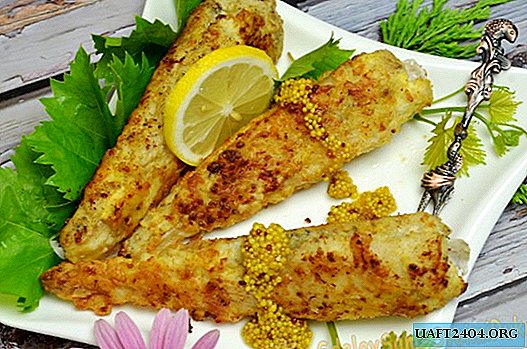Share
Pin
Tweet
Send
Share
Send

Products:
- hake - 800 g
- eggs - 2 pcs.,
- Dijon mustard - 1 tbsp. l.,
- flour - 1 tbsp., lemon - 1 pc.,
- sunflower oil - 100 ml,
- salt - 1 tsp,
- ground black pepper - 1/2 tsp.

Cooking sequence:
1. Milk hake is a small fish carcass. Milk hake can be fried whole, and a standard-sized fish is cut into 2-3 parts.
2. Without skin, hake carcasses are quickly pickled, and the finished fish is tastier. Skinned hake is a double fillet with spinal bone inside. The skin is quickly removed from the defrosted fish: the carcass is rinsed with cold water, longitudinal cuts are made along the ridge, fins are removed and the skin is removed with a thin knife.

3. The washed carcasses are washed and squeezed slightly, squeezing their palms. Cut half a lemon, squeezed out juice poured prepared carcasses. Sprinkle hake with salt and black pepper. Salts take only a pinch, and the rest is added to the batter. Hake is pickled in lemon juice for 10 minutes.

4. Break two small eggs or one large.

5. Mix the eggs with salt and Dijon mustard.

6. The carcasses are dipped in batter and cranked so that the flesh is well saturated with the egg-mustard mixture.

7. Bread carcass hake in flour.

8. Hake is fried in vegetable oil for 5-6 minutes on each side. If the fish is fried over low heat, the batter becomes a soft shell, only mustard seeds are fried until crunchy.

9. The remaining half of the lemon is cut into circles and served with fried fish. Decorate the carcasses with strips of Dijon mustard.

10. Usually, fried hake is served hot; after cooling it becomes harsh. But the fish fried in mustard batter is good in any form. The cooled carcasses remain soft and juicy, they appetizingly smell like lemon and black pepper.
11. Fried fish served with mashed potatoes, buckwheat, vegetable pilaf with long-grain rice. One fried carcass of a milk hake is enough for one serving.
12. The flesh of a milk hake is particularly tender, it does not have the fibrillation characteristic of large adult fish fillets. Milk hake is rarely used for ground and chopped dishes, the purpose of this fish is to fry in batter or stew in sauce.

Share
Pin
Tweet
Send
Share
Send











